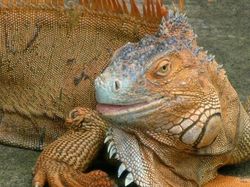| Iguana | ||||||||||||||
|---|---|---|---|---|---|---|---|---|---|---|---|---|---|---|
 |
||||||||||||||
| Scientific classification | ||||||||||||||
|
||||||||||||||
|
Lesser Antillean Iguana, I. delicatissima Green Iguana, I. iguana |
Although iguana can refer to other members of the lizard family Iguanidae, this article concerns members of the genus Iguana. For information on other genera, see Iguanas. For an article on the information on the species of iguana most commonly kept as pets.
Several species of this genus are common as pets, especially the Green Iguana in the United States and Canada, which can easily grow to six feet long, even in captivity. When treated well they can be docile, affectionate, litterbox trainable, and even walked on a leash. Such pets are either crèche-raised, or harvested from the wild in Mexico. The average life span of a well-cared-for of pet iguana is usually 20 years.
Captured iguanas kept as pets tend to be thin and nervous, often dying from side-effects of the stress of adapting to captivity - though if they're given a large swimming area in which to hide, their chances of survival improve, as they live on stream banks in the wild, diving in when alarmed or for other reasons. As they are cold-blooded creatures, they thrive in humid climates. The Green Iguana needs to be in temperatures of 75 to 90 °F (23 to 32 °C). If it is not kept under UVB lighting it can develop metabolic bone disease.
Iguanas can be considered as an invasive species, along the gulf coast of Florida, especially on Gasparilla Island (where there is an estimated population of over 12000). They commonly hide in the attics of houses, destroy gardens, and in beaches. As an introduced species, they contribute to natural habitat loss, spread salmonella, and could be responsible for the recent decline of the gopher tortoise. This is due to a combination of escaped and intentionally released iguanas which have survived and then thrived in their new habitat.
Contents |
Feeding
Iguanas are omnivores, which means they eat plants and meat, though usually tending to eat plants, mainly leaves and fruits. Sometimes iguanas (especially younger ones) will eat eggs, insects and other smaller vertebrae.
Habitat
Iguanas live in the neotropical rainforest, usually at lower altitudes near a water source (lake, river). They spend most of their time in the higher forest canopy, 15 meters (40-50 feet) above ground.
Species of Iguana
(after Frost et al.)
- Lesser Antillean Iguana, Iguana delicatissima
Green Iguana, Iguana iguana
Amblyrhynchus cristatus, "Marine Iguana"
Blue Iguana Cyclura lewisi
References
- Frost, D.E. and R.E. Etheridge (1989) A Phylogenetic Analysis and Taxonomy of Iguanian Lizards (Reptilia: Squamata). Univ. Kansas Mus. Nat. Hist. Misc. Publ. 81
- Frost, D.R., R. Etheridge, D. Janies and T.A. Titus (2001) Total evidence, sequence alignment, evolution of Polychrotid lizards, and a reclassification of the Iguania (Squamata: Iguania). American Museum Novitates 3343: 38 pp.

Illustration of an iguana in the 1851 "The
Illustrated London Reading Book"
|

An iguana found in
Costa Rica
|

An iguana found in
Cozumel
|

An iguana found in
Saint Thomas, United States Virgin Islands
|

Iguana found in
Manuel Antonio National Park
|

Lesser Iguana,
Dominica, W.I..
|

Marine Iguanas,
Galapagos Islands.
|

Land Iguana,
Galapagos Islands.
|